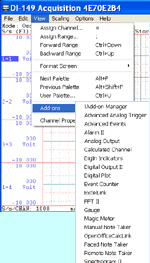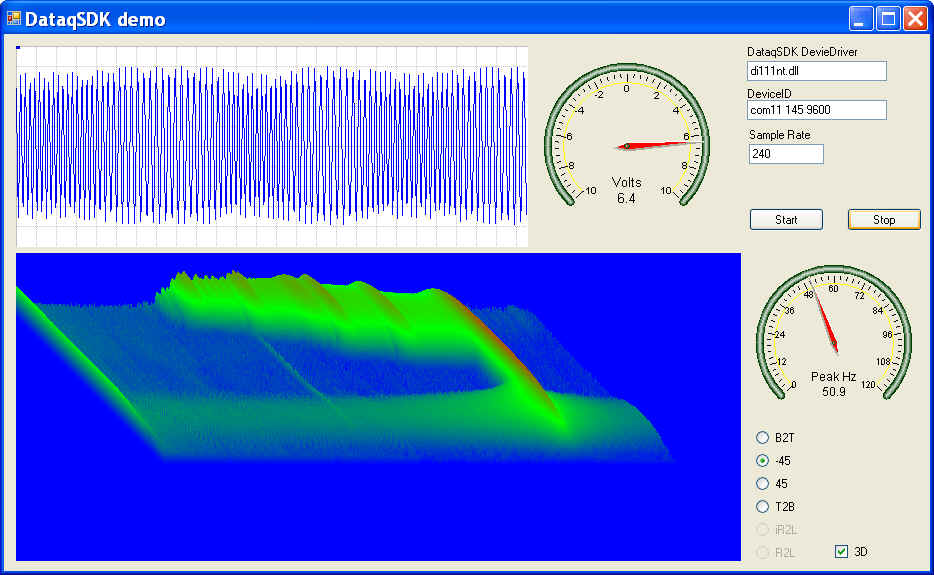
Programming Language and Components
Visual Studio 2010, where Express version can be downloaded for free from Microsoft's website, includes
- Visual Basic 2010
- Visual C++ 2010
- Visual C# 2010
32 or 64-bit?
Most ActiveXs are 32-bit components, you must select 32-bit code option when using 64-bit compilers. Both 32-bit and 64-bit Windows runs 32-bit applications properly.
We highly suggest you using DataqSDK.NET Class if you are starting a new project on products supported by the class
Screen Capture (The following is the output from Visual Basic 2010 Express Example)
Hardware
Any device supported by DATAQSDK ActiveX Control, which includes:
DI-149, DI-145, DI-148U, DI-154RS, DI-158U/UP, DI-194RS, DI-195B, DI-710, DI-715B, DI-718B, DI-718Bx, DI-720, DI-722, DI-730, DI-760, DI-785, DI-788 and DI-5001, Parallel port, USB, RS232 or Ethernet interface
Project Files Downlad
Visual Basic 2010 DataqSDK Example
Tutorial
To use ActiveX under Visual Basic Express
To use ActiveX under Visual C++ Express
Feature
Live analog waveform
Waterfall Spectrogram
Live Meters
How to determine Device Driver and Device ID
Some popular devices
- DI-720/730 USB
- DataqSDK DeviceDriver = "DI720NT.DLL"
- DataqSDK DeviceID="0"
- DI-720/730 Ethernet
- DataqSDK DeviceDriver = "DI800NT.DLL"
- DataqSDK DeviceID=<IP Address of the device>
- For example, if 720's IP address is 192.168.0.22, DeviceID="192.168.0.22"
- DI-145
- DataqSDK DeviceDriver = "DI1??NT.DLL", where ?? is the two-digit Virtual COM port number for the device
- DataqSDK DeviceID="COM?? 145 9600", where ?? is theVirtual COM port number for the device
- For example, if DI-145 is connected to Virtual COM 4, DeviceDriver = "DI104NT.DLL" and DeviceID="COM4 145 9600"
- DI-149
- DataqSDK DeviceDriver = "DI1??NT.DLL", where ?? is the two-digit Virtual COM port number for the device
- DataqSDK DeviceID="COM?? 149 38400", where ?? is the Virtual COM port number for the device
- For example, if DI-149 is connected to Virtual COM 13, DeviceDriver = "DI113NT.DLL" and DeviceID="COM13 149 38400"
- DI-155
- DataqSDK DeviceDriver = "DI1??NT.DLL", where ?? is the two-digit Virtual COM port number for the device
- DataqSDK DeviceID="COM?? 155 38400", where ?? is the Virtual COM port number for the device
- For example, if DI-155 is connected to Virtual COM 10, DeviceDriver = "DI110NT.DLL" and DeviceID="COM10 155 38400"
- DI-158
- DataqSDK DeviceDriver = "DI1??NT.DLL", where ?? is the two-digit Virtual COM port number for the device
- DataqSDK DeviceID="COM?? 158 38400", where ?? is the Virtual COM port number for the device
- For example, if DI-158 is connected to Virtual COM 5, DeviceDriver = "DI105NT.DLL" and DeviceID="COM5 158 38400"
- DI-71x USB
- DataqSDK DeviceDriver = "DI1??NT.DLL", where ?? is the two-digit COM port number the device connected to
- DataqSDK DeviceID="COM?? 710 38400", where ?? is the COM port number the device connected to
- For example, if DI-718 is connected to COM 8, DeviceDriver = "DI108NT.DLL" and DeviceID="COM8 718 38400"
- DI-148
- DataqSDK DeviceDriver = "DI1??NT.DLL", where ?? is the two-digit Virtual COM port number for the device
- DataqSDK DeviceID="COM?? 148 38400", where ?? is the Virtual COM port number for the device
- For example, if DI-148 is connected to Virtual COM 3, DeviceDriver = "DI103NT.DLL" and DeviceID="COM3 148 38400"
- Please refer to this document for more info
Source Codes
Visual Basic 2010 Example...Class Form1 Dim v(,) As Short Dim v2(,) As Short Private Sub Button1_Click(ByVal sender As System.Object, ByVal e As System.EventArgs) Handles Start.ClickPublic
TrueAxDataqSdk1.DeviceDriver = TextBox1.Text
AxDataqSdk1.DeviceID = TextBox2.Text
AxDataqSdk1.SampleRate = Val(TextBox3.Text)
AxDataqSdk1.ADChannelCount = 1
AxDataqSdk1.EventPoint = 1
AxDataqSdk1.Start()
AxUltimaMeter2.MaxValue = AxDataqSdk1.SampleRate / 2
TextBox3.Text = AxDataqSdk1.SampleRate
Timer1.Interval = 10
Timer1.Enabled =
Timer2.Interval = 50
Timer2.Enabled =
True End Sub Private Sub Button2_Click(ByVal sender As System.Object, ByVal e As System.EventArgs) Handles Button2.ClickFalseAxDataqSdk1.Stop()
Timer1.Enabled =
Timer2.Enabled =
False End Sub Private Sub Timer1_Tick(ByVal sender As System.Object, ByVal e As System.EventArgs) Handles Timer1.TickDim dTemp As Double If AxDataqSdk1.AvailableData > 0 ThenEnd If End Subv = AxDataqSdk1.GetData
AxXChart1.Chart(v)
dTemp = Val(v(0, 0))
AxUltimaMeter1.Value = dTemp / 3276.8
Private Sub Form1_Load(ByVal sender As System.Object, ByVal e As System.EventArgs) Handles MyBase.Load
AxUltimaMeter1.MinValue = -10
AxUltimaMeter1.MaxValue = 10
AxUltimaMeter2.MinValue = 0
AxUltimaMeter2.Unit = "Peak Hz"
AxUltimaWaterfall1.ChartType = ULTIMAWATERFALLLib.enumCharType.uw3D
AxUltimaWaterfall1.ChartDirection = ULTIMAWATERFALLLib.enumCharDir.uwNSlope
AxUltimaWaterfall1.ScalingMethod = ULTIMAWATERFALLLib.enumColorScale.uwBGR
End Sub
Private Sub Timer2_Tick(ByVal sender As System.Object, ByVal e As System.EventArgs) Handles Timer2.TickDim i As Shortv2 = AxDataqSdk1.GetDataFrame(1024)
For i = 0 To 1023Next iAxFFT10241.SetWaveformPt(i, v2(0, i))
AxFFT10241.FFTNow(1024)
AxUltimaWaterfall1.Chart(AxFFT10241.Power)
AxUltimaMeter2.Value = AxUltimaMeter2.MaxValue * (AxFFT10241.GetPeakIdx() / 512)
End Sub Private Sub RadioButton1_CheckedChanged(ByVal sender As System.Object, ByVal e As System.EventArgs) Handles RadioButton1.CheckedChangedIf Timer1.Enabled Then AxUltimaWaterfall1.ChartDirection = ULTIMAWATERFALLLib.enumCharDir.uwB2T End Sub Private Sub CheckBox1_CheckedChanged(ByVal sender As System.Object, ByVal e As System.EventArgs) Handles CheckBox1.CheckedChangedIf Timer1.Enabled ThenIf CheckBox1.CheckState = CheckState.Checked ThenAxUltimaWaterfall1.ChartType = ULTIMAWATERFALLLib.enumCharType.uw3D
RadioButton6.Enabled =
FalseRadioButton4.Enabled =
False ElseTrueAxUltimaWaterfall1.ChartType = ULTIMAWATERFALLLib.enumCharType.uw2D
RadioButton6.Enabled =
RadioButton4.Enabled =
True End If End If End Sub Private Sub RadioButton6_CheckedChanged(ByVal sender As System.Object, ByVal e As System.EventArgs) Handles RadioButton6.CheckedChangedIf Timer1.Enabled Then AxUltimaWaterfall1.ChartDirection = ULTIMAWATERFALLLib.enumCharDir.uwR2Lx End Sub Private Sub RadioButton2_CheckedChanged(ByVal sender As System.Object, ByVal e As System.EventArgs) Handles RadioButton2.CheckedChangedIf Timer1.Enabled Then AxUltimaWaterfall1.ChartDirection = ULTIMAWATERFALLLib.enumCharDir.uwNSlope End Sub Private Sub RadioButton5_CheckedChanged(ByVal sender As System.Object, ByVal e As System.EventArgs) Handles RadioButton5.CheckedChangedIf Timer1.Enabled Then AxUltimaWaterfall1.ChartDirection = ULTIMAWATERFALLLib.enumCharDir.uwT2B End Sub Private Sub RadioButton3_CheckedChanged(ByVal sender As System.Object, ByVal e As System.EventArgs) Handles RadioButton3.CheckedChangedIf Timer1.Enabled Then AxUltimaWaterfall1.ChartDirection = ULTIMAWATERFALLLib.enumCharDir.uwSlope End Sub Private Sub RadioButton4_CheckedChanged(ByVal sender As System.Object, ByVal e As System.EventArgs) Handles RadioButton4.CheckedChangedIf Timer1.Enabled Then AxUltimaWaterfall1.ChartDirection = ULTIMAWATERFALLLib.enumCharDir.uwR2L End SubEnd
Class
Visual C++ 2010 Example...<stdio.h>#include
#include
<stdlib.h>#include
<math.h>#include
<vcclr.h>...
private
: System::Void button1_Click(System::Object^ sender, System::EventArgs^ e) {axDataqSdk1->DeviceDriver=textBox1->Text;
axDataqSdk1->DeviceID=textBox2->Text;
axUltimaMeter1->MaxValue=10;
axUltimaMeter1->MinValue=-10;
axDataqSdk1->SampleRate=Double::Parse(textBox3->Text);
axUltimaWaterfall1->ChartType=ULTIMAWATERFALLLib::enumCharType::uw3D;
axUltimaWaterfall1->ChartDirection=ULTIMAWATERFALLLib::enumCharDir::uwSlope;
axDataqSdk1->EventPoint=1;
timer1->Interval=10;
timer1->Enabled=1;
timer2->Interval=50;
timer2->Enabled=1;
axDataqSdk1->Start();
}
private
: System::Void button2_Click(System::Object^ sender, System::EventArgs^ e) {timer1->Enabled=0;
timer2->Enabled=0;
axDataqSdk1->Stop();
}
private
: System::Void timer1_Tick(System::Object^ sender, System::EventArgs^ e) {if (axDataqSdk1->AvailableData >0){array<Int16, 2>^ Data = (array<Int16, 2>^)axDataqSdk1->GetData();axXChart1->Chart(Data);
axUltimaMeter1->Value=(
double)Data[0,0]/3276.8;}
}
private
: System::Void axDataqSdk1_ControlError(System::Object^ sender, AxDATAQSDKLib::_DDataqSdkEvents_ControlErrorEvent^ e) {timer1->Enabled=0;
timer2->Enabled=0;
}
private
: System::Void timer2_Tick(System::Object^ sender, System::EventArgs^ e) {array<Int16, 2>^ Data2 = (array<Int16, 2>^)axDataqSdk1->GetDataFrame(1024); int i; for (i=0; i<1024; i++){double)Data2[0,i]);axFFT10242->SetWaveformPt(i,(
}
axFFT10242->FFTNow(1024);
axUltimaWaterfall1->Chart(axFFT10242->Power());
}
Visual C# 2010 Example........
private void button1_Click(object sender, EventArgs e)
{
axDataqSdk1.DeviceDriver=textBox1.Text;
axDataqSdk1.DeviceID=textBox2.Text;
axUltimaMeter1.MaxValue=10;
axUltimaMeter1.MinValue=-10;
axDataqSdk1.SampleRate=Convert.ToDouble(textBox3.Text);
axUltimaWaterfall1.ChartType = ULTIMAWATERFALLLib.enumCharType.uw3D;
axUltimaWaterfall1.ChartDirection = ULTIMAWATERFALLLib.enumCharDir.uwSlope;
axDataqSdk1.EventPoint=1;
timer1.Interval=10;
timer1.Enabled = true;
timer2.Interval=50;
timer2.Enabled = true;
axDataqSdk1.Start();
}
private void button2_Click(object sender, EventArgs e)
{
timer1.Enabled = false;
timer2.Enabled = false;
axDataqSdk1.Stop();
}
private void timer1_Tick(object sender, EventArgs e)
{
if (axDataqSdk1.AvailableData > 0)
{
object V;
short[,] intArray;
V = axDataqSdk1.GetData();
axXChart1.Chart(V);
intArray = (short[,])V;
axUltimaMeter1.Value = intArray[0, 0]/3276.8;
}
}
private void timer2_Tick(object sender, EventArgs e)
{
object V;
short[,] intArray;
short i;
V = axDataqSdk1.GetDataFrame(1024);
intArray = (short[,])V;
for (i=0; i<1024; i++){
axFFT10241.SetWaveformPt(i, intArray[0, i]);
}
axFFT10241.FFTNow(1024);
axUltimaWaterfall1.Chart(axFFT10241.Power());
}
private void axDataqSdk1_ControlError(object sender, AxDATAQSDKLib._DDataqSdkEvents_ControlErrorEvent e)
{
timer1.Enabled = false;
timer2.Enabled = false;
axDataqSdk1.Stop();
MessageBox.Show("Error: Please check DeviceDriver and DeviceID");
}
Last update: 11/18/16
© www.ultimaserial.com

